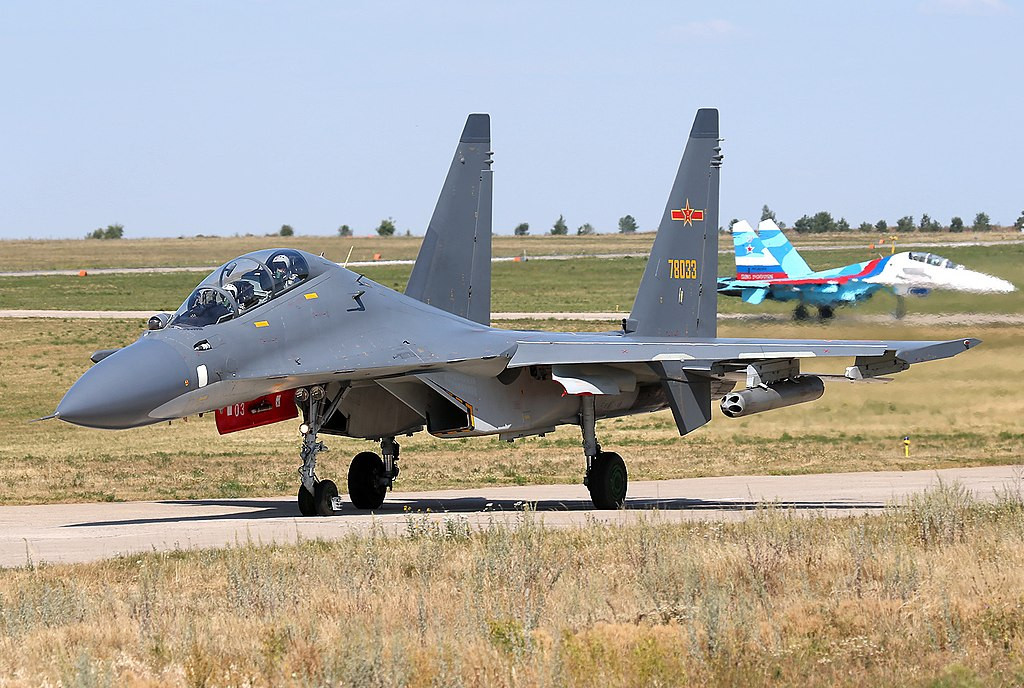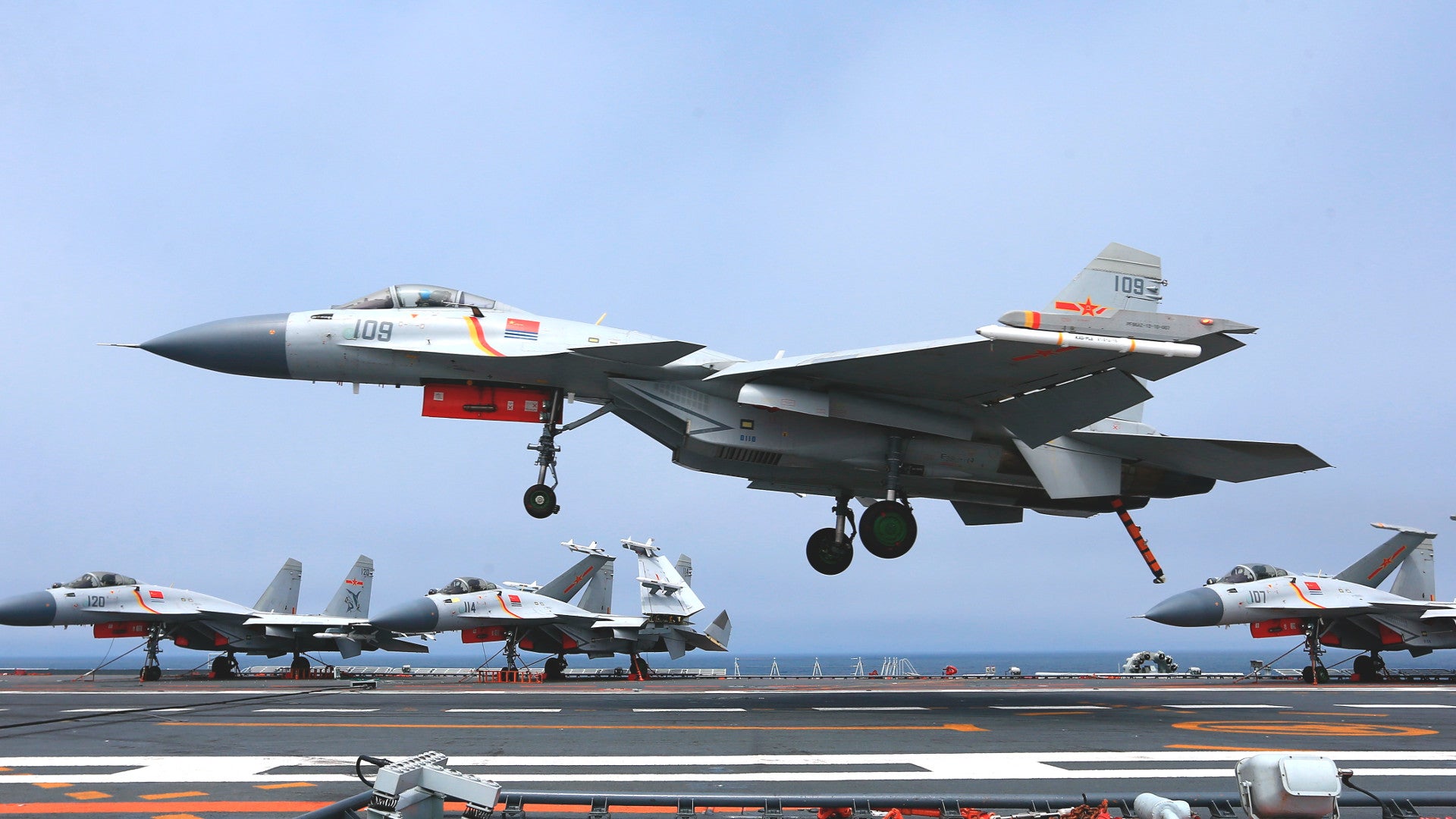China is reportedly working on a replacement for the People’s Liberation Army Navy’s J-15 carrier-based fighter jet. This news comes amid revelations that the aircraft are increasingly accident prone and the Chinese already need to significantly expand their carrier aviation fleets to keep pace with plans to build new flattops.
The South China Morning Post
confirmed that China’s Navy, also known as the PLAN, was searching for a new carrier fighter on July 4, 2018. Though Chinese officials say that a new type is in development, there was no information on whether this would be a variant of an existing aircraft, either produced domestically or acquired abroad, or a clean-sheet design, or when it might enter service.
Lieutenant General Zhang Honghe, deputy head of the People’s Liberation Army Air Force, or PLAAF, acknowledged the project was in progress, according to the South China Morning Post, but declined to give any specifics. The existing J-15 is a derivative of the Soviet-era Su-33 Flanker-D and first flew in 2009. The Su-33’s basic design, however, traces back to the 1980s.
The J-15 forms the core of the carrier air wing on board China’s first aircraft carrier, the Type 001 Liaoning, which itself entered service in 2012. The PLAN’s first domestically produced carrier, known presently simply as the Type 001A, started its sea trials in May 2018. A third “Type 002” ship is reportedly under construction and China has plans for at least four carriers in the coming years, each one of which will need an air wing. That’s not counting any additional aircraft it might need to create a steady pipeline of pilots to go along with those jets.

While there are no official details about what the J-15’s successor will look like, there are a number of possibilities. One option would be to simply improve upon the existing aircraft. In addition to the single-seat fighters, Shenyang Aircraft Corporation has made a limited number of J-15S trainers, which may now serve as testbeds for further improved designs.
In May 2018, pictures emerged of a what some have referred to as a J-15D or J-17, a two-seat variant with what appeared to be electronic warfare jamming pods on the wingtips. This could be an important addition to Chinese carrier air wings, regardless of the main type of aircraft it is flying.
In a similar vein, the PLAN could look to acquire a navalized variant of the more modern J-16, which China reportedly derived in part from the more modern Su-30MKK Flanker-G, or a version of that latter jet straight from Russia. The PLAAF operates both Su-30MKKs and J-16s already from land bases. It also began receiving even more advanced Su-35 Flanker-Es from Russia in January 2018.
Still, the PLAN’s experiences with the J-15 could make them disinclined to go with another Flanker derivative. If nothing else, these aircraft are heavy, with an empty weight of 38,600 pounds. This makes them one of the heaviest carrier-borne fighter jets, ever.

On top of that, the Liaoning and the future Type 001A are both Short Take-Off But Arrested Recovery (STOBAR) types that use ski-jumps to help the aircraft get airborne. Even so, the planes have to fly with reduced weapons and fuel loads to be light enough to get off the deck safely.
In addition, “the J-15 is a problematic aircraft – its unstable flight control system was the key factor behind the two fatal accidents two years ago,” an unnamed Chinese military source told the South China Morning Post. The individual was referring to a pair of crashes in April 2016, including one mishap in which the pilot, Zhang Chao, died. The other pilot, Cao Xianjian, survived, but suffered serious injuries.

“But the aviation experts at first refused to acknowledge that the J-15 has design problems,” another one of the South China Morning Post’s sources said. “They only agreed there were problems after Cao encountered the same trouble.”
The incidents left the J-15s grounded for three months. The South China Morning Post reported that the relatively small fleet of jets – Shenyang only ever produced approximately 20 in total – has seen at least four crashes, even though state authorities have only admitted two so far.
The incidents in 2016 came as the PLAN pushed to declare the Liaoning combat ready. In August 2017, the engine on another one of the fighters caught fire after an apparent bird strike, but this did not prompt a fleet-wide grounding.

It’s not clear if the reported flight control system issues would necessarily persist with the more advanced Su-30MKK or J-16, either. It is worth noting, however, that in 2010, the Russians themselves began purchasing the lighter MiG-29K Fulcrum as the replacements for their own aging Su-33s on their carrier, the Admiral Kuznetsov.
The Indian Navy also went this route for their STOBAR carrier INS Vikramaditya, though they are reportedly less than pleased with the performance of these aircraft, as well. Among the factors that played into that decision was the outdated avionics on the Su-33s.
It is possible that the PLAN could acquire a number of MiG-29Ks, or variants thereof, at least as an interim option. It could then decide to either craft a copy of this type or develop a new domestic carrier fighter for future carriers. It might be difficult for the Chinese to clone the Fulcrum, or at least do so quickly, as they have never operated the type.

A small purchase of an existing type, or one that would require minimum development, might make even more sense since the Type 002 carrier, as well as other future Chinese flattops, will reportedly have a Catapult Assisted Take-Off But Arrested Recovery (CATOBAR) configuration. This will significantly change the weight and performance requirements for the planes flying off those ships, which will open up new possibilities for what kind of aircraft they can accommodate and could change the calculus for the PLAN as it outlines the structure of their air wings.
It could also provide the additional time necessary to complete development of a fifth generation carrier fighter design. Speculation has persisted for some time that Shenyang could be developing its FC-31 medium-weight stealth jet (also referred to as the J-31) as a carrier fighter. The Aviation Industry Corporation of China (AVIC), the country’s state-run aviation conglomerate, has said it could have a production-ready model by 2019.

However, AVIC has long insisted that the aircraft is primarily for export and that it is looking for a foreign buyer to help finance the completion of the plane’s development. With two prototypes of the design already, the latest of which is substantially more advanced than the first, a derivative of FC-31 could easily turn out to be an attractive option for the PLAN.
If Shenyang could develop a version that is suitable for STOBAR operations, as well, it could also complement or replace any fighter jets China buys in the meantime for the Liaoning and the future Type 001A carrier. There is also the distinct possibility that the PLAN is looking to supplement these manned aircraft with stealthy unmanned combat air vehicles (UCAV) on the Type 002 and any further CATOBAR carriers, too.
Whatever courses of action China chooses, it will have to make those decisions sooner rather than later, if it hasn’t already. The PLAN is expanding at an aggressive rate and is expecting to commission its third carrier by 2023. Those ships won’t be particularly useful without any aircraft to go on them.
And, to be fair, the loss of four aircraft is significant, but it isn’t a major surprise. To be fair to China, carrier aviation operations are extremely complex and challenging and require significant training and regular drills to maintain competency. The U.S. Navy has experienced its own share of mishaps, and the Russians dumped two jets in the water during its sole carrier’s most recent cruise. China’s aircraft carrier aviation program is still so young, and there is so much to learn in general.
China has gone on a propaganda blitz that seems aimed, at least in part, in presenting a positive picture of things as they stand now. Earlier in 2018, it awarded Zhang, the pilot who died, the title of “best party member,” a significant accolade. State-run CCTV also aired a special on Cao, who will be among the People’s Liberation Army’s representatives at the Communist Party’s congress in October 2018, another major honor.
Cao and his comrades are probably hopeful that this high profile attention will translate into getting newer, more capable planes and quickly.
Contact the author: jtrevithickpr@gmail.com
